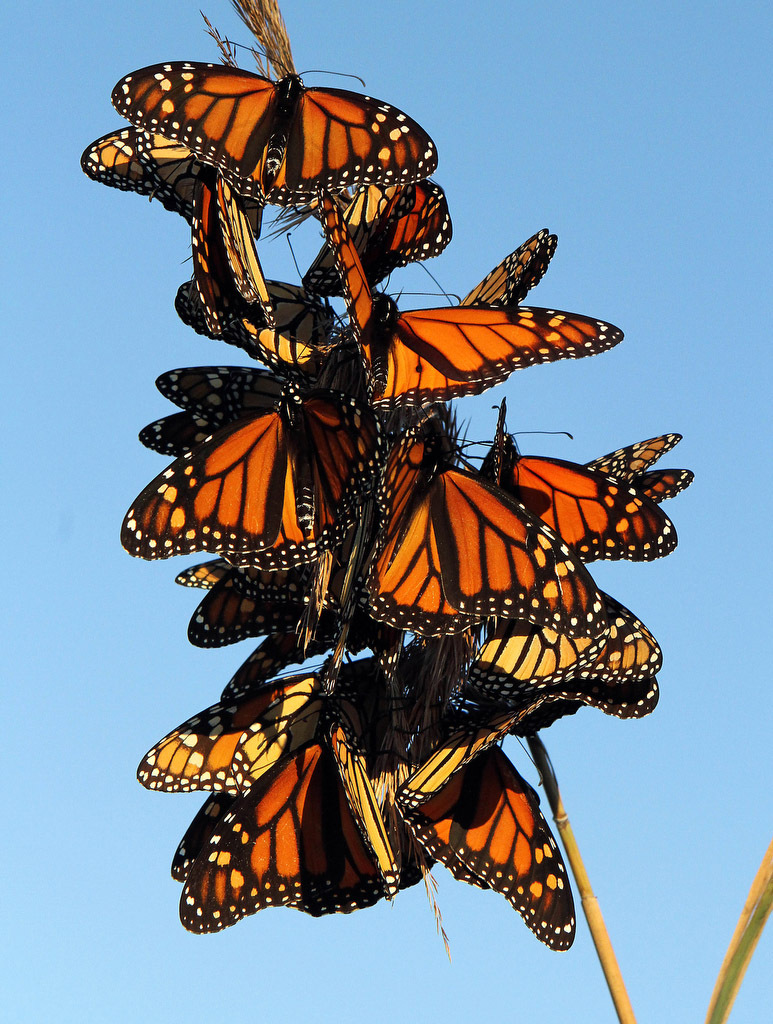For the monarch butterflies, life is complicated enough even in a good year. Now, though, they’ve got to deal with Texas.
The monarchs in recent weeks have been beating their way south and west across eastern North America, riding winds a thousand feet above the ground, covering 25 miles or more every day. Now they’ve reached a vast area in Texas stricken by drought and charred by wildfires.
The butterflies are on their way to Mexico. They come from as far north as Winnipeg and as far east as the islands of Maine. Many take a well-flapped route down the Eastern Seaboard before veering across the Gulf Coast.
If they can make it through the gauntlet of Texas, they will cross the Rio Grande and eventually converge on a few acres of forest in mountains about 60 miles west of Mexico City. There they’ll roost over the winter, thick as quilts on oyamel fir trees. In spring they’ll head back north.
But it’s not clear how many will make it this year to their Mexican retreat, or what kind of condition they’ll be in when they get there.
They need water. They need flowers. They need nectar. The monarch butterfly is a hardy and vigorous animal, but whatever compels it to migrate to Mexico does not tolerate much flexibility in the itinerary. Going through Texas on the way to Mexico is what they’re hard-wired to do. And Texas is scorched.
“They’re going to be encountering a thousand miles of hell as they go through a nearly waterless, flowerless, nectarless landscape,” said Chip Taylor, an insect ecologist at the University of Kansas and the director of the nonprofit organization Monarch Watch.
Experts expect to see the smallest overwintering population ever recorded. From 1994 to 2003 the monarchs covered an average of 23 acres of forest, but since then the average has dropped to fewer than 11 acres.
The butterflies typically arrive fat and happy, having gorged on nectar for thousands of miles. If they arrive thin and bedraggled they could be more vulnerable to winter storms and below-freezing temperatures.
The monarch butterfly — Danaus plexippus — has been making this trek in eastern North America for thousands of years. Only in recent years has the migratory adventure of the monarch been carefully studied and mapped. The overwintering site in Mexico was not discovered by researchers until 1975.
A critical problem for the butterflies is the adoption by farmers of herbicide-tolerant corn and soybeans, Brower said. These genetically modified crops enable farmers to spray herbicides on their fields and wipe out weeds without hurting the corn or soybeans.
But the milkweeds that are eradicated are crucial to the life cycle of the butterflies. Scorned by farmers, milkweeds are a diverse genus of plants, with more than 120 species identified, that co-evolved with the butterflies.
“We’re talking about hundreds of thousands of acres of land that are virtually sterilized except for human food crops,” Brower said.
The butterfly isn’t endangered, but this amazing migratory pattern could be, Brower said.
“It’s an endangered biological phenomenon,” he said.
Copy the Story Link
Send questions/comments to the editors.



Success. Please wait for the page to reload. If the page does not reload within 5 seconds, please refresh the page.
Enter your email and password to access comments.
Hi, to comment on stories you must . This profile is in addition to your subscription and website login.
Already have a commenting profile? .
Invalid username/password.
Please check your email to confirm and complete your registration.
Only subscribers are eligible to post comments. Please subscribe or login first for digital access. Here’s why.
Use the form below to reset your password. When you've submitted your account email, we will send an email with a reset code.